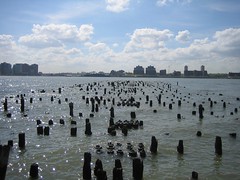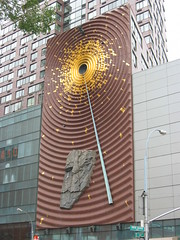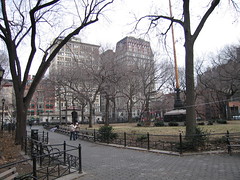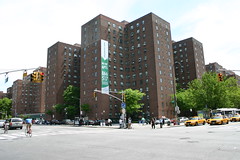South:

Corner (145 4th Ave):
NYU's School of Continuing and
Professional Studies was formerly Touro College.
Built on the site of Jacob Abraham's bookstore, a
shop on the famous Bookseller's Row that was used
to pass messages to German spies during World War I. Earlier,
this address was sculptor
Augustus Saint-Gaudens' studio.
106: The site of Huber's Dime Museum, a
sideshow-style enterprise that exhibited
Dr. Henry S. Tanner, who gained notoriety by
surviving a 40-day fast in 1880. Escape artist Harry Houdini
performed here in 1891, at the age of 17;
he reportedly learned the rope-tie trick
from Huber's barker.
University Hall

110: NYU structure built by Davis Brody Bond in
1998. Built on site of
Luchow's (1882), a famous German restaurant.
Piano maker William Steinway ate here daily, and his
patronage helped make it a hangout
for music figures from Enrico Caruso to Cole Porter to
Leonard Bernstein, as well as writers like H.L. Mencken, O. Henry and
Theodore Dreiser, and such politicians as Al Smith and
Theodore Roosevelt. Victor Herbert conducted the house
orchestra every Sunday.
The ASCAP was founded here; "Yes Sir, That's My Baby"
was written on a Luchow's tablecloth in 1925.
Luchow's building was put up in 1840 and was demolished
in 1995; University Cafe now feeds people in its stead.
114: Buildings from here to No. 134 were
damaged or destroyed in
"one of the fiercest fires on record"
at the Hippotheatron on December 24, 1872.
Later, in 1910, the 2,000-plus-seat
City Theatre was built on this site
by cinema mogul William Fox; it was the first theater
designed by famed theatrical architect Thomas W. Lamb.
After different incarnations showing vaudeville,
legitimate theater and newsreels--but mostly movies--it
was demolished in 1952.
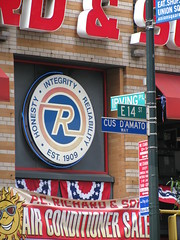
116: P.C. Richard appliance store
is on the site of Gramercy
Gym, where boxing legend Cus D'Amato trained Floyd
Patterson and Jose Torres. Torn down 1993. Note "Cus
D'Amato Way" streetsign.
126: The address of the
Dewey Theater,
a vaudeville and burlesque house opened in 1898 in
a former church by Tammany Hall's Big Tim Sullivan.
(It was named for Spanish-American War hero Admiral Dewey.)
In 1908, the theater was leased to William Fox--as in
20th Century Fox--who started alternating vaudeville acts
with silent movie reels, bringing in an average of 9,000
customers a day. In 1916, the building's conversion was
declared unsafe and it was torn down; the New Academy
of Music was built on its site.
132: The address of Grace Chapel, built 1876.
Presumably this was church that became the Dewey.
136: Here was the
Theatre Unique,
a penny arcade that became one of the first
houses to project films. It was torn down by
1926, when the New Academy of Music was built
in part on its space.
Palladium Hall
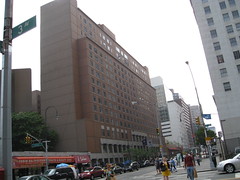
140: NYU dorm built by Davis Brody Bond
in 2001; The Palladium, popular 1980s dance club,
was torn down to build
it--along with Julian's, one of the all-time classic pool
halls, which shared the building.
The Palladium was built in 1926 as the
New Academy of Music, a 3,600-seat cinema built for William Fox and
designed by Thomas W. Lamb, replacing the old
Academy of Music across the street. The cinema was not a
success, the entertainment district having moved
uptown to Times Square, and Fox lost it along with
the rest of his theater empire in the Great Depression.
While operating for decades as an increasingly shabby movie house,
it also featured music shows, including performances
by Tito Puente in the 1950s that helped fuel the
mambo craze.
The venue began showing rock acts in 1964--including
the Rolling Stones, Beach Boys, Kinks, Black Sabbath,
King Crimson, Alice Cooper, Yes, Grateful Dead,
Byrds, Fleetwood Mac, Lou Reed, Stooges,
New York Dolls, Genesis, Springsteen, Crazy Horse,
Frank Zappa, Todd Rundgren, Patti Smith, Ramones, David Bowie,
Elvis Costello and Blondie (in all cases--when
they were good!). It was one of New York's
main rock venues--especially after the Fillmore East
closed--though it's remembered as something as a pit.
It was rechristened The Palladium--named for a mythical
image of Athena that protected
 the city of Troy--with
a show by The Band in 1976. The guitar-smashing
cover photo of The Clash's London Calling was
taken at a Palladium show.
the city of Troy--with
a show by The Band in 1976. The guitar-smashing
cover photo of The Clash's London Calling was
taken at a Palladium show.
In 1985 it became a
multi-level disco, with a conversion designed
by Arata Isozaki. The building was demolished c. 1997.
After being vacant for several years, the ground
floor of the new dorm became a Trader Joe's in 2006,
to great hooplah.
Corner: The empty building on the corner
was
Disco
Donut, where Robert De Niro took Jody Foster
in
Taxi Driver. Upstairs
was Carmelita's Reception House, a sketchy
club used in the audience-participation play
Tony and Tina's Wedding. (New Wave band
The B-52s
stayed here when they first came to New York.)
It was closed
down after the 1990 Happyland fire resulted in
a safety-code crackdown.
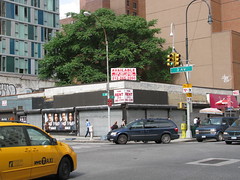 The upper floors of the
building were removed in a deal that allowed NYU to build
Palladium Hall higher--a strange public policy that
rewards the creation of squat buildings like this one.
Most recently Robin Raj Discount Drugs was here.
The upper floors of the
building were removed in a deal that allowed NYU to build
Palladium Hall higher--a strange public policy that
rewards the creation of squat buildings like this one.
Most recently Robin Raj Discount Drugs was here.
|
